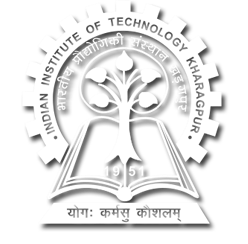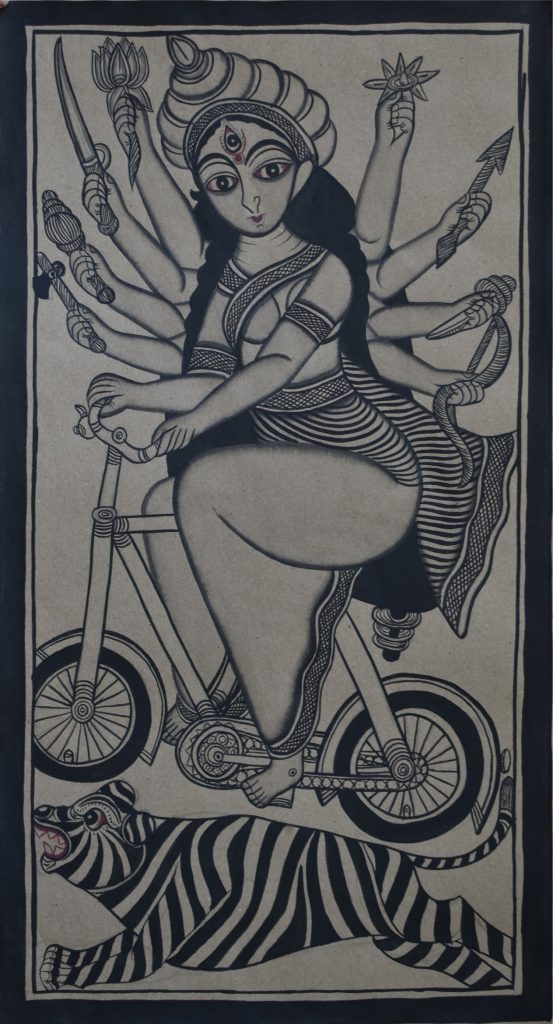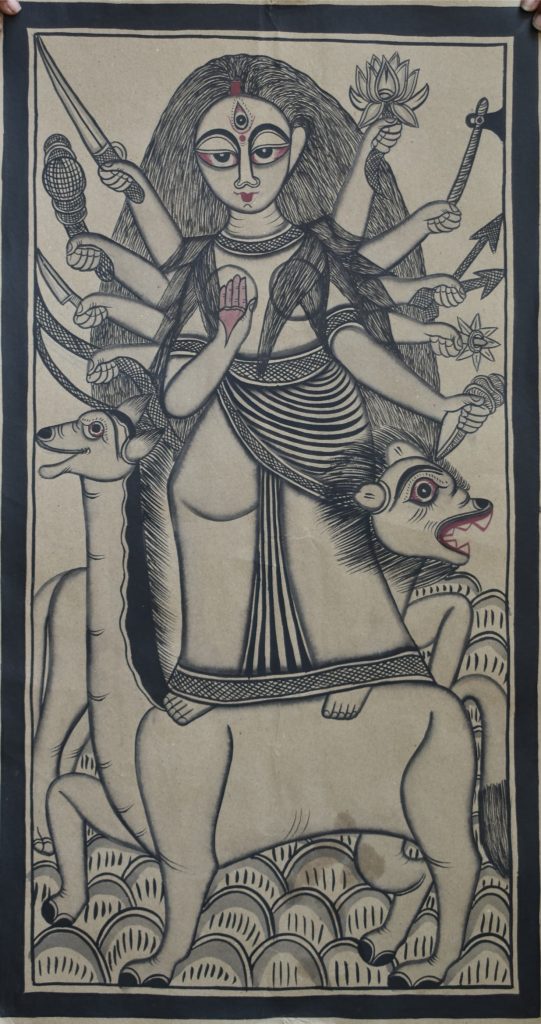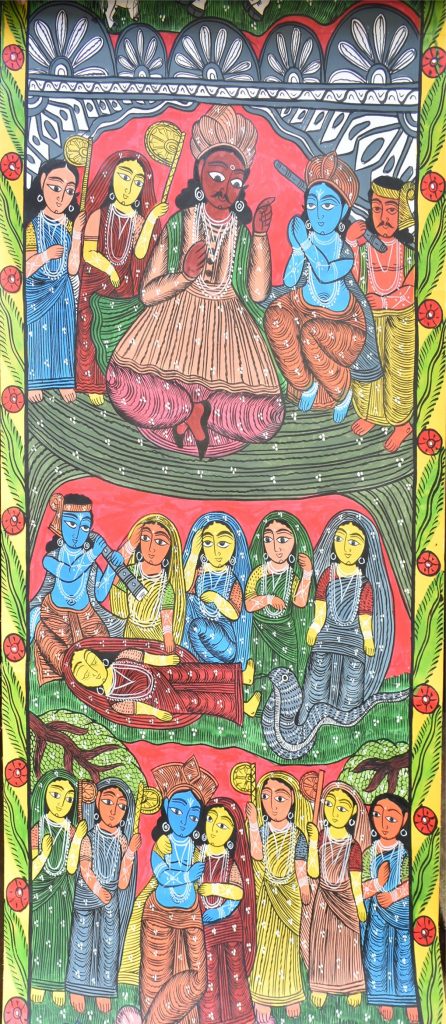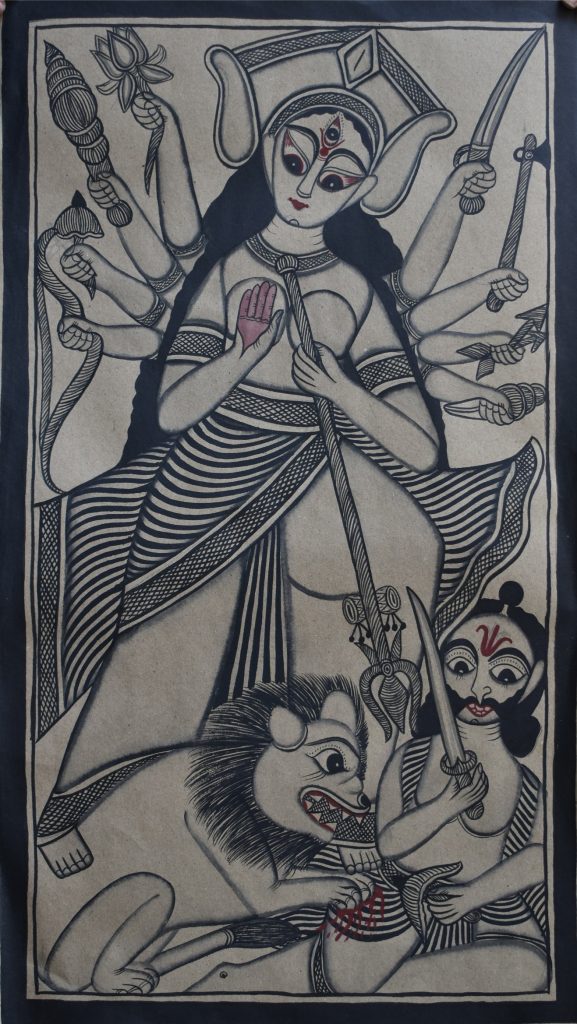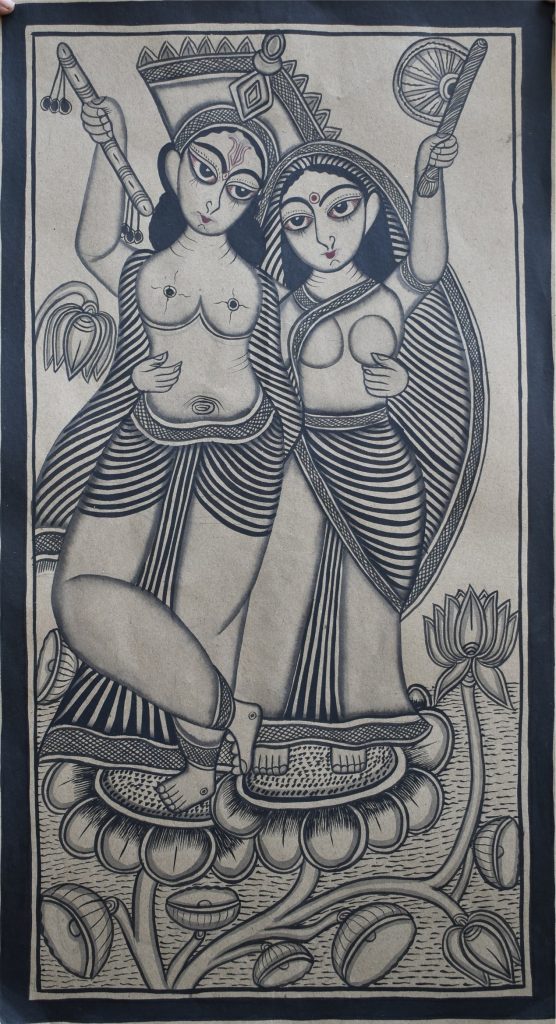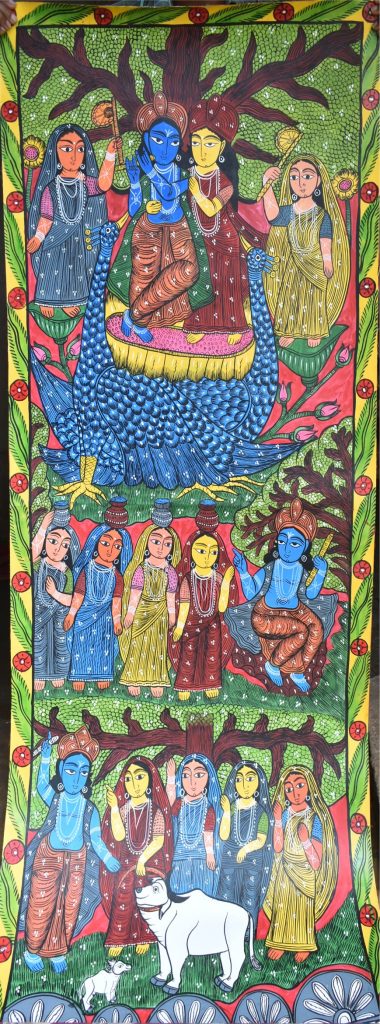Transcript
Interviewer: Kindly introduce yourself.
Rahim Chitrakar: My name is Rahim Chitrakar and I am a pata artist (patua). I am from Pingla, Naya village. You are here at Pingla, Naya at the house of Rahim Chitrakar.
The colour used in patachitra is made from vegetable dyes. But vegetable dyes are used only while painting on patas. While painting on t-shirts, scarves, saris and other cloth, we use fabric colours. In all the colours that we use, we mix the resin of Bengal quince. The resin is mixed in order to increase the longevity and the brightness of the colours. Also, it looks good.
Interviewer: Apart from the resin of the Bengal quince, what do you use?
Rahim Chitrakar: We also use the resin of the gum Arabic tree.
Even the resin from the rain tree is mixed with the dye. This is how the colour is prepared.
Interviewer: If you could you please throw some light on your childhood… I mean how have you spent your childhood here?
Rahim Chitrakar: I learnt painting from my father, when I was a mere school-going kid. I used to go to school. I also learnt pata songs from my father. I used to accompany my father when he visited several places. The first place I went to, was Kolkata. From there, we went to several other places as well. Now, I travel all by myself. I have been to several states of India. I have also visited foreign countries. I have been to Tokyo and also Bangladesh. There was an Indian cultural festival in Tokyo. I liked it a lot! I gained a lot of experience from that trip. I was very happy with that visit. Upon visiting that place, we realised that artists are highly valued by the Japanese people. The sales had also been good. I was nominated for by banglanatak.com. It’s been eight years since my visit to Japan. Yes…almost seven to eight years. After that, I have been visiting several places in different states of the country.
Interviewer: Are artists valued more in foreign countries than in India?
Rahim Chitrakar: I am travelling from India. It is because of our own people and their immense interest in art, that I am able to establish myself and travel far and wide. Had they not been this supportive, we, the artists could never have made this far. Be it the ministers, the government or the organisations…had they not cooperated, I could never have visited any foreign country. Indian people know and value art and culture. That is why we have been nominated to travel to different countries. I really liked the experience of visiting Japan. Not bad. The Japanese are very warm. They also have a sound knowledge about art and folk culture. I really liked it a lot!
Interviewer: What is your opinion on the way the government functions in India?
Rahim Chitrakar: The scenario has undergone several changes. The condition of the artists has improved since Didi (the honorable Chief Minister of West Bengal) came to power. She has allotted a monthly stipend for the artists. We get a monthly stipend of one thousand rupees. She has also been organising several fairs. Earlier, only handicraft fairs were held. We did not have such a variety of fairs and exhibitions earlier. But nowadays, the government is organising several fairs for the development of the artist community. That has benefitted the artists and has ensured that artists get ample opportunities.
Interviewer: Okay. So, do you think that with TMC (the ruling party in West Bengal) coming to power, things have improved for your community?
Rahim Chitrakar: Yes, of course. It has improved significantly.
Interviewer: Okay, so it has improved.
Rahim Chitrakar: Definitely.
Interviewer: How was the previous situation?
Rahim Chitrakar: Earlier, there weren’t enough opportunities for us. There was just one handicraft fair that was organised by the state government. No other fairs were organised. Even if they organised one, they didn’t invite any artist.
Interviewer: Okay. So, there was no invitation from their end.
Rahim Chitrakar: No, we were never invited. But now, we are participating in several fairs like the Shabola Mela and even in the Kolkata Book Fair. There was a time when patuas weren’t allowed inside the premises of the book fair but now things have changed. Patuas are not just being granted entry, but are also allowed to sell their patas. They are making some money there as well. At least they are given the opportunity to sell their stuff on the premises of the book fair. Now, so many fairs are being organised. We have fairs at places like Medinipur, Santiniketan, and even Siliguri. There are innumerous fairs being organised in Kolkata, every two to three months. Patuas are getting an opportunity to participate in all these fairs. This has helped improve the condition of the artist community.
Interviewer: What kind of help do you get from NGOs?
Rahim Chitrakar: As I already mentioned, that with the help of banglantak.com, a lot of improvement has taken place in our lives. The former government did not offer us much help. In comparison to our previous condition, things have improved a lot. Well…maybe not everyone has benefitted. But quite a few did. Patuas are travelling far and wide for participating in various programmes. They are getting recognition. Patachitra has earned worldwide fame and has been able to make its way to a large number of people. Mainly, what needs to be emphasized is the fact that patachitra has been widely promoted. Several NGOs and also the government have taken the initiative to promote our work. banglanatak.com had played a vital role in this and even till this date, it plays a crucial role. Every year, around mid-November, they organize a fair here, in Naya. That works as a great platform for promoting our work. We are also able to sell our products during this fair. Many people visit this fair which lasts for three days.
Interviewer: Okay. Have you received any help from any NGO other than banglanatak.com?
Rahim Chitrakar: We haven’t received any help from any NGO, but several colleges have come forward and organized workshops and exhibitions for us. They have provided us with ample opportunities. We had the renowned activist Ruby Pal Chowdhury with us but I won’t be able to throw light on it since I was a kid back then. The professors in the colleges here often organize several exhibitions revolving around patachitra. We receive help from different quarters, not just from the NGOs.
Interviewer: With time, how has patachitra gradually evolved? Could you kindly throw some light on that?
Rahim Chitrakar: Patachitra has not changed much. Only the media has changed. Earlier, patachitra was practiced only on paper and cloth. But the NGO (banglanatak.com) has helped bring about a change. Not everyone would be able to buy a pata. They can, perhaps buy one and use it as a wall hanging. But now, patachitra is being painted on t-shirts as well. We have also given much thought as to how patachitra can be painted on t-shirts. These days, patuas are painting not just on t-shirts, but also on saris, panjabis, fans made from palm leaves and various other stuff like these. You’ll get a glimpse of all these things if you visit a handicraft fair. That is how the overall development of the patua community is taking place. Even till this day, we have those long scrolls. The small, square patas do not have songs accompanying them. But the long scrolls have pata songs.
Interviewer: Okay. So, have the songs changed over the years? Or have they remained the same?
Rahim Chitrakar: We have different kinds of patas. Earlier, we had patas on mythological stories. Now, we have patas on contemporary, social events as well. So, we paint such patas and as well as compose songs on them. Government policies like the Kanyashree, Yuvashree, topics like drug addiction, the necessity of building toilets are all promoted through patachitra. We are raising awareness regarding these issues in every area, every block. A monthly stipend is transferred to our account for promoting these. It is directly being sent to our bank accounts and this initiative has been taken by our honorable Chief Minister.
Interviewer: Okay.
Rahim Chitrakar: So, this is how things function.
Interviewer: Which patas have a higher demand?
Rahim Chitrakar: The mythological ones – the ones that are based on the Ramayana, the Mahabharata, Manasa Mangal, Durga etc.
Interviewer: Okay, these patas have a higher sale.
Rahim Chitrakar: Yes. The ones based on the contemporary social events are temporary. They have a short-termed popularity. When a certain policy or an event takes place we compose a pata on that. The popularity of the pata lasts as long as the event/policy is there. After that, it’s forgotten. But patas based on mythology are ever-lasting. They will survive the ravages of time. Other patas on new topicsmight suddenly gain some prominence, but it will eventually dwindle away.
Interviewer: Right, it is temporary.
Rahim Chitrakar: Yes.
Interviewer: Do you depict all the seven episodes from the Ramayana or just selected ones?
Rahim Chitrakar: Both.
Interviewer: Do you still paint all the seven episodes?
Rahim Chitrakar: Yes, if someone orders us to paint all the seven episodes, we do that.
Interviewer: How long are these scrolls? Which ones are longer – the mythological ones or the ones based on contemporary, social events?
Rahim Chitrakar: The ones based on mythology are usually very long. Patas based on the stories of Raja Harishchandra, the benevolent Karna, Naramedh Yagna, Humayana, the Mahabharata are very long. These scrolls are about twenty-five to thirty feet long.
Interviewer: Okay…twenty five to thirty feet… What is the length of the longest scroll that you have made?
Rahim Chitrakar: I don’t compose such long scrolls.
Interviewer: You don’t compose such long scrolls.
Rahim Chitrakar: The reason why I don’t compose such long scrolls is that I usually compose customized patas. I compose patas according to the exact measurements as mentioned by the customers. Usually, I don’t compose patas longer than ten to twelve feet.
Interviewer: Okay.How do you get to know how the customer wants the pata to be composed or the number of patas that s/he wants to be composed? How do you get these orders for customized patas?
Rahim Chitrakar: Suppose you come and ask me to compose me two patas for your friend because you want an artistic work to be given as a wedding present. The dimensions of the patas are mentioned as well. The topics are either decided by them or by us. When they ask me to decide the topic, I usually suggest them the Ramayana or a mythological story. Sometimes, I ask them to tell us if they want the pata to be based on a mythological story or a contemporary one. So, they often tell us what to do. That is how it works.
Interviewer: Who are usually the ones who ask you to compose such customized patas?
Rahim Chitrakar: We often get such orders for customized patas from certain colleges. Again, there are individuals who order such patas for the purpose of gifting them to their friends staying abroad. Sometimes, we get such orders from people who want patas to adorn their newly-built houses.
Interviewer: Okay. So, many people from various places visit this village. Right?
Rahim Chitrakar: Yes. Many people visit this place – not just people from our own country, but also from others countries.
Interviewer: Okay. Let’s talk about the next generation. Are they still interested in patachitra and practising it?
Rahim Chitrakar: In a patua’s family, no one has to be taught painting separately. This is the main thing. A patua’s son or a daughter doesn’t have to be trained. They learn painting simply by observing the other patua members in their family. If a school organizes a painting competition, you’ll always find that children hailing from the patua families will inevitably win the first prize. This is quite an amusing thing!
Interviewer: Are they interested in taking up patachitra as their profession? Or are they opting for other professions, especially now that they are getting educated as well?
Rahim Chitrakar: They are getting educated. Education is compulsory. Thirty to forty years back, the scenario was different. Patuas did not have enough money. Moreover, the art of patachitra was not this well recognized. Therefore, patuas had to wander about villages displaying their patas and singing pata songs. That is how they earned their living. But times have changed. The state of the patuas has improved a lot. Sales have improved. Patachitra is now a well recognized art form. Patuas are being invited to several places. Now the problem is that the earlier generation of patuas who did not receive any education is unable to communicate with a foreigner in English. We need a translator (a Bengali or an Indian) in order to be able to communicate. So, after being duped several times because of this communication gap, they have shown a keen interest in getting their children educated. They are getting their children educated so that at least our children don’t get duped like us. Our children should be able to directly able to communicate in English, without any assistance from a third person.
Interviewer: Okay.
Rahim Chitrakar: That is why children are learning painting as well as being sent to school.
Interviewer: Are there instances where they have chosen an occupation other than patachitra?
Rahim Chitrakar: No, nothing like that.
Interviewer: How would you react if they chose a different occupation?
Rahim Chitrakar: I don’t think they would choose any other occupation. If they want to choose a different profession, that is up t them. I won’t be able to tell you why. I won’t be able to throw light on that.
Interviewer: Okay.
Rahim Chitrakar: In that case, I guess we need to presume that the family doesn’t practice patachitra anymore. That is why their children are getting inclined towards other professions and are abandoning patachitra. In patua families, where patachitra is practiced and where the members are well connected to people from foreign countries, the children would by no means opt for a different profession. They would never abandon patachitra. By no means!They would surely follow this profession.
Interviewer: Okay. Do people from your generation know the pata songs as well?
Rahim Chitrakar: No, they don’t know the songs that well. The young generation knows how to paint the patas, but would not be able to sing the pata songs. The government and also the NGOs organize a three-month or six-month long workshop in order to train the patuas. My father, Dukhushyam Chitrakar is a patua instructor. He has trained all the patuas living here. My father teaches pata songs to the new generation in such workshops. The Research Centre over there organizes a three month long workshop for training the patuas to learn pata songs. Not painting. Painting is something that can be done by anyone. But not everyone knows the pata songs. My father has been appointed to teach them these songs. These workshops run for a course of three months. Such initiatives are taken so as to ensure that pata songs do not get obliterated. Such a workshop is being conducted now.
Interviewer: Being conducted now?
Rahim Chitrakar: Yes.
Interviewer: People here, are all by and large followers of the Islamic tradition. Despite that…
Rahim Chitrakar: Religion has no relationship, whatsoever, with an art form. These are two completely different things. They are not one and the same thing. Religion is one area and an artist’s creation is a completely different area. Religion, caste and creed have got nothing to do with this. Even a Christian can be a good painter. His/her eagerness, his/her passion for the art form is what matters. S/he can paint if she feels like doing it. It has got nothing to do with one’s religious affiliations. Religious bigots often mislead people but then, that’s not acceptable.
Interviewer: But then, most probably, Islam specifically mentions that people of this faith cannot accept any other religious deity.
Rahim Chitrakar: It’s not about acceptance. We can paint but cannot worship any other religious deity.
Interviewer: So, there’s no religious reservation regarding this…
Rahim Chitrakar: No, there’s no religious reservation as such. But we cannot worship these deities. We can paint. But no matter what, at the end of the day, we all have specific religious identities. We have embraced the Islamic faith and our religion forbids painting. This is what has been preached by some people as well. But wise men have stated otherwise. They have clearly said that painting is not a sin, but getting too deeply involved in that is a sin. One cannot whole heartedly embrace everything that one paints. One is definitely allowed to paint, especially because s/he is doing that for a living. But oneis not allowed to get too attached to what s/he paints. Then that would become problematic.
Interviewer: Are you able to practice patachitra in exactly this manner?
Rahim Chitrakar: Yes, we have been practicing patachitra in this manner.
Interviewer: But this is something that you are practising on a regular basis. Right? Do you believe that it does not affect you at all?
Rahim Chitrakar: No, it doesn’t. We only know one thing – we are artists and our creation is what matters the most. Nothing else matters.
Interviewer: Has nobody ever tried forbidding you from doing this? Has no one ever tried creating any hindrance?
Rahim Chitrakar: No, no. No one ever did that because people who know the worth of this art form would never try creating any sort of hindrance.
Interviewer: One thing about this place is that it’s not just the content that follows Hinduism, but many of the patuas have names…
Rahim Chitrakar: We compose patas on both Hindu and Muslim stories. We have patas based in Muslim themes like Satya Pir, Gaji Pir, Manik Pir, Masandali PIr. We compose patas on Muslim as well as Hindu stories.
Interviewer: Okay.
Rahim Chitrakar: We do not have any reluctance in doing that. Artists can do whatever they feel like. There is nothing that can deter them from following that.
Interviewer: Yes, of course. But then, a lot of patuas here have Hindu names.
Rahim Chitrakar: True.
Interviewer: Is there any particular reason behind that?
Rahim Chitrakar: No, there’s no particular reason in such. As I have already mentioned, patuas used to wander about villages, displaying their patas and singing pata songs. They used to travel for four to five days at a stretch and reach distant villages. They often put up at other’s houses. If a Muslim put up at a Hindu’s place then that used to be frowned upon, since Muslims were somewhat hated by Hindus. But now, that superstition does not exist anymore. But it was very much in practice at one point of time. Maybe in some places, it still exists. But I don’t know. I won’t be able to tell you much about that. But this discriminatory practice was prevalent. If a Muslim stepped inside a Hindu household, the Hindus used to ‘cleanse’ the area after they left. They thought that their house had been sullied by the touch of Muslims and they performed certain rituals in order to cleanse the defiled area. So, the Hindus never allowed a Muslim patua inside his/her house. That is why Muslims adopted a Hindu name and put up at Hindu households. They stayed there for around four to five days, They displayed their patas, sang pata songs, earned a little money or a handful of rice and then finally came back to their native villages. That is why they had two names. They used their Muslim name when they were in their village, but used a Hindu name when they put up at someone else’s place. That is why patuas had two names. An individual had two names. Sometimes they used their Muslim name, and sometimes they used the Hindu name. My father has two names – Osman and Dukhushyam. There’s another patua living over there, named Gurupada Chitrakar. He has another name Jummon Chitrakar. Jummon and Gurupada are the names of the same individual. That is why patuas had two names. Patuas have become Muslim recently. Earlier, they were not Muslims, but Hindus. But they liked the Islamic tradition so much, that they embraced it whole heartedly and converted their religion. But nowadays, in some families, children are being given Muslim names. These days, people are not given two names anymore.
Interviewer: Okay, okay.
Rahim Chitrakar: All their identity cards – their Aadhar Card, voter card, school identity card bear their Muslim name. For example, I have got just one name, Rahim. My brother’s name is Rahman. My sons have also got Muslim names. We do not have any other name.
Interviewer: Okay.
Rahim Chitrakar: That is why, earlier, patuas had two names.
Interviewer: You just mentioned that patuas were initially Hindus who later converted their religion. When did this happen?
Rahim Chitrakar: That happened a long time back. My father would be able to throw light on that. I won’t be able to tell you much. Perhaps, I was this young back then. If you need information about these things, you should visit my father. He is a very talented and a renowned artist. Moreover, he has a sound knowledge about everything – even about events that took place a hundred years back. My father had heard stories from my grandfather. Moreover, he is highly experienced as well. If you want to meet him, you can visit the backside of this house. He’s there. He is one of the senior most members of the community. He is also a teacher. He writes. He composes pata songs. He is a patua. Please visit him. He’s a wonderful artist.
Interviewer: Okay.
Rahim Chitrakar: That is why, whenever someone visits this place for collecting information, banglanatak.com sends them to my father. You should visit my father first. My father is a store house of knowledge. He can help you furnish with facts so much so that you won’t need to visit any other patua for anything else. If you want to know about these events, you should visit him. Go and speak to him. But he is an older member of the community and you’ll have to give him something as a token of respect. Probably, he won’t be able to tell it directly but then, all senior members of the community are ought to be given some financial support for this.
Interviewer: Of course!
Rahim Chitrakar: If you want to know all these things, please visit my father. He would be able to help you. He’s there.
Interviewer: People from our team have spoken to your father earlier.
Rahim Chitrakar: Okay.
Interviewer: Since, religious identities are so important to people living here, has there been any case of a riot?
Rahim Chitrakar: Religious friction?
Interviewer: Yes.
Rahim Chitrakar: No, nothing like that has happened. I don’t know if it had taken place earlier. My father would be able to tell you. I don’t know. I haven’t experienced any such thing.
Interviewer: This village is a pretty recent settlement. Right?
Rahim Chitrakar: Yes, Naya means new. This village did not have such a sprawling population earlier. People have migrated from several places and settled down here.
Interviewer: Okay.
Rahim Chitrakar: This used to be a deserted place. There was no settlement. The settlement here is pretty recent and that is why it has been named Naya (new). All the patuas living here have migrated from other places. The earlier settlement of patuas used to be there, at Vishaalpara. It is from that area that patuas gradually started moving here. Patuas used to put up at this place, when they wandered about villages displaying their patas. They used their Hindu names while staying here. They used to stay here for eight to ten days, display their patas and then return home. They were mainly from Thekuachawk, Purba Medinipur. Patuas, by and large, are from Thekuachawk.
Interviewer: Okay.
Rahim Chitrakar: They came all the way from Thekuachawk. They couldn’t travel to and fro. That is why, they put up at this place. Thekuachawk is around thirty to forty kilometers away from this place. so, they didn’t travel regularly. They put up at this place. They wandered about the neighbouring villages, displayed their patas, earned some money and some rice and went back home. They started travelling frequently. The Vishaal family then gave away a portion of their land to the patuas so that they could settle down here. That is how the patua community came to settle down at Naya.
Interviewer: There are patuas from Purba Medinipur as well.
Rahim Chitrakar: Yes, there are some patuas in Purba Medinipur as well.
Interviewer: How different are they from this patua community here?
Rahim Chitrakar: They are not different. They have all moved to this place. You won’t find a separate patua settlement in Purba Medinipur. Patuas from there have migrated to this village. As I have already mentioned, Thekuachawk is in Purba Medinipur. Nandigram, Hanshchawra, Chandipur are all villages in Purba Medinipur. Patuas from those places moved here. They used to come here to display their patachitra. They came here for ‘parabas’. Parabas literally means staying at someone else’s house. They put up for eight to ten days. Mostly, patuas from Purba Medinipur have migrated to this place.
